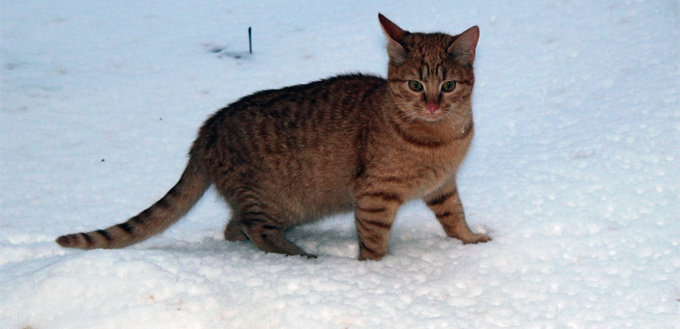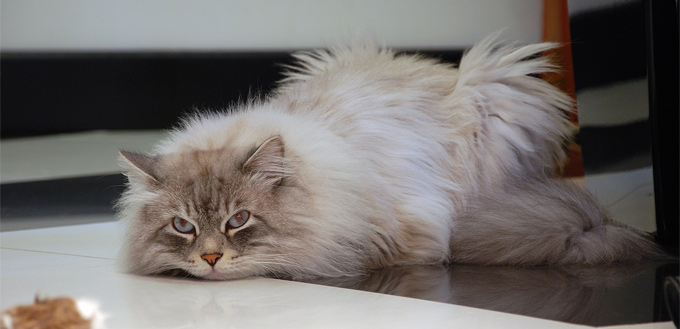A cat’s tail is more than just a body part. He uses it to convey how he’s feeling, to express himself, to communicate, to keep himself warm, and for balance. Cat tail injuries tend to be uncommon in indoor cats, but are more common in outdoor cats.
Most Common Tail Injuries
There are a number of tail injuries that are more common than others.
Bite Wounds
Bite wounds are probably the most common tail injury. Cats can get into fights with other cats, and other animals, and it’s possible that the other animal can bite your cat as he’s trying to run away. The most important thing with a bite wound is that it’s kept clean and free from infection. If the wound is small, it will probably heal by itself. A larger wound may need to be seen by your veterinarian as your cat may need antibiotics and pain medication.
Abrasions
An abrasion is a scratch or small cut, which may have occurred if your cat scrapes his tail on an abrasive surface. He may have some hair loss, and the area may look red. Most abrasions will heal on their own. You may want to clean it with some cooled, boiled water. If you put anything more than that on it, such as an antiseptic ointment, then you will need to bandage it to prevent your cat from licking the ointment.
Burns
It should be quite unusual for your cat to sustain a burn injury, but it can happen. You will need to take your cat to the vet as soon as possible. What you do will depend on the type of burn it is. If it’s a thermal burn caused by fire or heat, you’ll need to apply a cold compress. If it’s a chemical burn, then you’ll probably need to flush the area with water.

Abscesses
Abscesses are usually secondary to an initial injury, like a cut, bite or abrasion. An untreated abscess can become serious. You should clip the hair from around the abscess and apply a warm, moist compress to try to draw the pus out. You’ll need to keep it on for about 20 minutes and repeat three times a day. If after two to three days, there’s little or no improvement, then you should see your vet have them drain it.
Skin Infections
Skin infections can be caused by bites or wounds, but they can also be caused by fleas or an allergic reaction. The skin can become inflamed, appear red, and your cat may experience itchiness. You may feel tempted to treat a skin infection at home with a topical ointment, but it’s not usually a good idea. Cats are particular about their grooming routine, and will probably lick the ointment off, which could be dangerous for them. Instead, you should see your vet. The cause of the infection will need to be identified, and fleas would need to be treated. Your cat may need a steroid injection to help with the itching, and antibiotics to treat the infection.
You May Also Like: Flea Collars for Cats, Flea Comb for Cats and Flea Shampoo for Cats.
Self Mutilation
Self-mutilation of the tail can appear similar to a skin infection and can cause a skin infection. This is usually down to fleas, allergies, or stress, which should be treated in the same way as a skin infection, but on rare occasions can be a symptom of a more unusual condition. Feline hyperesthesia syndrome can cause twitching along the spine and tail, which is distressing and causes the cat to self-mutilate. This condition is often treated with medications used for treating seizures.
Fractures and Dislocations
Fractures and dislocations are usually caused by some sort of trauma, such as being hit by a car. You may not notice any symptoms, or you may notice your cat’s tail drooping, or sitting at an unusual angle. Some fractures can be minor and may heal on their own. If the fracture is severe, then there may be no other option but to remove the tail.
Degloving
Degloving is an injury where the skin is torn away from the tail. This type of injury is seen if the cat has been dragged by a car, but can also be seen if your cat has caught his tail on something. You should call your vet immediately, as this part of the tail will need to be amputated. However, in some cases, your vet may need to wait before performing an amputation if, for example, the cat is too young to comfortably undergo anesthetic. You should still see your vet who will advise you to keep the cat indoors in a clean area, keep the tail clean, and will probably advise you not to put any topical creams or ointments on the tail in case the cat licks it. In most cases, your vet will probably want to amputate down to the normal tissue as soon as possible.
Fan Belt Injuries
Cats will look for warm places, especially in cold weather, and a car engine can seem like a perfect place for a nap. However, when the engine starts, the cat’s tail can become trapped. Often this will cause injuries like degloving, but it can also cause nerve damage and paralysis. Sometimes it can injure the nerves that help control the bladder. Amputating the tail can often restore the bladder function, but they can also be fatal.

What to Do in an Emergency
The most important thing you can do is stay calm. He’s probably highly stressed, and you won’t help him if you are as well. You should remember that no matter how well you know your cat, he may behave completely differently under stress. Pay extra attention or you could end up being scratched or bitten. If you can’t get to your regular vet, you should take his medical records with you. You’re probably going to be upset and stressed as well, so you may not remember all the important information. You’ll need to call the vet and follow their advice for administering first aid at home before you transport him to the clinic. You may need to use a cat crate to take him to the vet, but if possible have someone sit in the back with him. They will need to talk to him calmly and in a reassuring voice. If you don’t have a cat crate, you can wrap him in a towel, but make sure that he can’t get his claws out, or he could injure the person holding him. You need to act quickly, but remaining calm is the most important thing.
Related Post: Stud Tail In Cats: Causes, Symptoms, and Treatment
Sources:
- Maura McAndrew, 7 Common Cat Tail Injuries, PetMD
- Krista Williams, BSc, DVM, First Aid for Tail Injuries in Cats, VCA Hospitals
Note: The advice provided in this post is intended for informational purposes and does not constitute medical advice regarding pets. For an accurate diagnosis of your pet's condition, please make an appointment with your vet.






